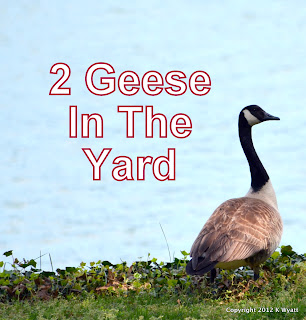We have a pair of 'resident' geese living on our creek.
Today they decided to pay the westies a visit
and I really wish they didn't.
It was a Bark-fest to who laid the rail!
So today's lesson ... boys and girls is all about geese.
. . .
THE FACTS PLEASE
. . .
The most familiar and widespread goose in North America,
the Canada Goose, can be found all across the continent,
from the tundra in Canada to the Gulf Coast.
In appearance, a “resident” Canada goose is identical to a migrant.
The only differences between a resident and migrant are that
the resident breeds in the United States and does not migrate.
The “acid test” to determine residency is the presence of nests
and goslings in the contiguous United States during the spring breeding season.
There are an estimated 5 million resident geese and just
2 million migrant Canada geese in the continental US today.
DESCRIPTION OF OUR GEESE FRIENDS
Size: 30-43 inches Wingspan: 50-67 inches
Weight: 6-15 pounds
Male and female; juvenile and adult birds all look very similar.
DID YOU KNOW THAT GEESE ...
* Eat more than 1-5 pounds of grass per day
* Produce about 1-2 lbs of waste per day
* Average about 5 goslings per year
* Mate for life and will stay together throughout the year
* Are federally protected by the Migratory Bird Treaty Act
* Mating season is February to early April
* Geese will find a new mate if the mate is killed or dies
* Geese return to the area of their birth each year to mate and nest
DON'T EVEN CONSIDER BUILDING
YOUR NESTING SPOT HERE!
NESTING
* Nesting season is Mid March to May.
* Geese begin to nest at the age of 2.
* Geese will return to the exact site of the previous years nest
or sometimes a nearby pond or other body of water.
* The average number of eggs in a nest is 5-6 but there can be as many as 10-12.
* Incubation time is 28 – 30 days.
HATCHING/MATURING
* The goslings will be able to fly in 2-3 months.
* During the maturing time the adult geese do not leave the area.
* The geese will attack humans while protecting their young.
* The maturing period of the goslings overlaps with the molting
season for the adults.
MOLTING
* Molting season runs from early June to late July.
* Adult geese lose wing feathers during this time & are unable to fly.
* Geese can fly again approximately 6 weeks after molting.
* Generally by August all geese are able to fly.
* During the molt geese need to be near water (any water) for
easy escape from predators.
MIGRATION
* Migration season is October through March.
* Migratory geese flight range can be 2 – 3 thousand miles.
* Migratory geese do not become resident geese unless they are injured.
* Resident geese do not know how to migrate.
Migration is a learned behavior - not instinct - and
the birds must learn to migrate from their parents.
If the adults do not migrate, each new generation will also not migrate.
Lobster ... Lobster ... Who Wants Lobster?
The new treats in the house ... freeze dried lobster meat
The new treats in the house ... freeze dried lobster meat
at $12.99 for this tiny package.
Last but not least ... beautiful flowers.













Oh Katie and Julep you are so darn cute. This post has just made my doggie day!!!
ReplyDeleteLobster treats!! How cool! Great post too!
ReplyDeleteon now...those things scare the you know what out of me!!!
ReplyDeleteThe geese around our lake get on my nerves. Bonnie does not like them, either! They hiss at us, and they can be aggressive! I hate it when they poop on the walking trail, too. :?
ReplyDeleteDerby and Julep have very sophisticated taste...lobster!!! Wow. Bonnie Blue likes butter beans and corn bread!
xo,
RJ
Oh my goodness that picture with the warning on it cracked me up. My how ferocious....lol
ReplyDeleteHahaha, too funny about the Bravo lobster. I too know the woes of having dogs with expensive taste!
ReplyDelete